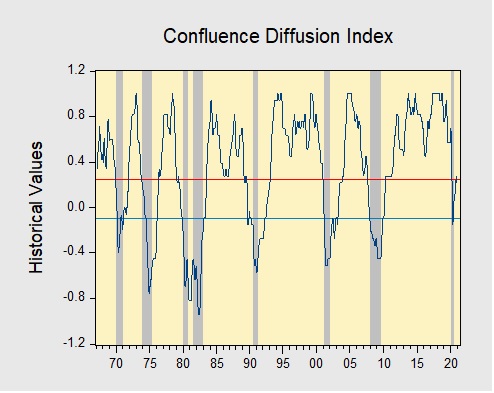Business Cycle Report (January 28, 2021)
by Thomas Wash | PDF
The business cycle has a major impact on financial markets; recessions usually accompany bear markets in equities. The intention of this report is to keep our readers apprised of the potential for recession, updated on a monthly basis. Although it isn’t the final word on our views about recession, it is part of our process in signaling the potential for a downturn.
In December, the diffusion index rose further, signaling that the economy remains on track to continue its recovery. Financial markets were mixed; equities strengthened, while the yield curve steepened as vaccine production boosted growth expectations and lifted inflation expectations. Meanwhile, the labor market had a setback as a rise in COVID-19 cases led to new lockdown restrictions. Manufacturing remains strong as a weaker dollar promoted more exports abroad. As a result, four out of the 11 indicators are in contraction territory, unchanged from last month. The reading for December remained unchanged from the previous month at +0.2727, above the recession signal of +0.250.
The chart above shows the Confluence Diffusion Index. It uses a three-month moving average of 11 leading indicators to track the state of the business cycle. The red line signals when the business cycle is headed toward a contraction, while the blue line signals when the business cycle is headed toward a recovery. On average, the diffusion index is currently providing about six months of lead time for a contraction and five months of lead time for a recovery. Continue reading for a more in-depth understanding of how the indicators are performing and refer to our Glossary of Charts at the back of this report for a description of each chart and what it measures. A chart title listed in red indicates that indicator is signaling recession.



